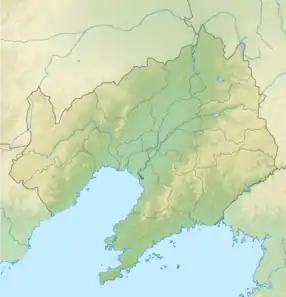Tuchengzi Formation
The Tuchengzi Formation (formerly known as Tucheng Conglomerate, from Chinese: 土城子; pinyin: Tǔchéngzǐ) is a geological formation in China whose strata span the Tithonian (Late Jurassic) to Berriasian (Early Cretaceous) ages.[1] Dinosaur fossils, particularly footprints, have been found from the formation.[3][4]
| Tuchengzi Formation | |
|---|---|
| Stratigraphic range: Tithonian-Berriasian ~[1] | |
| Type | Geological formation |
| Underlies | Zhangjiakou Formation |
| Overlies | Tiaojishan Formation |
| Thickness | 870–2,900 metres (2,850–9,510 ft)[2] |
| Lithology | |
| Primary | Shale |
| Other | Sandstone, mudstone |
| Location | |
| Coordinates | 42.9°N 124.0°E |
| Approximate paleocoordinates | 44.1°N 126.1°E |
| Region | Beijing, Hebei, Liaoning |
| Country | |
| Type section | |
| Named for | Tuchengzi, Beipiao, Liaoning |
| Named by | Chao-Chi Lin |
| Year defined | 1942 |
 Tuchengzi Formation (China)  Tuchengzi Formation (Liaoning) | |
Fossil content
Color key
|
Notes Uncertain or tentative taxa are in small text; |
The Tuchengzi Formation was deposited during a time of transition between the Daohugou Biota and the Jehol biota. The Tuchengzi represents a poorer, more arid climate that appears to have caused much of the Daohugou fauna to become extinct. They would later be replaced by the Jehol biota when conditions became more favorable to a diversity of terrestrial animal life.[1]
Reptiles
Indeterminate sauropod remains formerly attributed to the Mamenchisauridae and Brachiosauridae have been found in Liaoning, China.[3] Theropod tracks, including those made by avialans, have been found in Liaoning, China.[3]
| Genus | Species | County | Member | Abundance | Notes | Image |
|---|---|---|---|---|---|---|
| Orientognathus | O. chaoyangensis | Chaoyang, Liaoning.[5] | "An incomplete skeleton (41HIII-0418)".[5] | A rhamphorhynchid pterosaur. | ||
| Chaoyangsaurus | C. youngi | Liaoning.[6] | "Partial skull with mandible, cervicals, humerus, and scapula."[7] | A basal ceratopsian. | ||
|
Grallator isp. |
Footprints belonging to the Grallator form taxon, made by an unknown small theropod.[8] |
|||||
|
Menglongipus |
M. sinensis |
Hebei |
Footprints belonging to the Menglongipus sinensis form taxon, made by an unknown small (~65 cm long) deinonychosaur[8] |
|||
Plants
| Genus | Species | County | Member | Abundance | Notes | Images |
|---|---|---|---|---|---|---|
| Brachyoxylon | B. yanqingense | Yanqing District, Beijing.[9] | Fossil wood.[9] | |||
| Xenoxylon | X. latiporosum | Yanqing District, Beijing.[10] | Fossil wood.[10] | |||
| X. peidense | Yanqing District, Beijing.[10] | Fossil wood.[10] | ||||
References
- Liu Y.-Q. Kuang H.-W., Jiang X.-J., Peng N., Xu H. & Sun H.-Y. (2012). "Timing of the earliest known feathered dinosaurs and transitional pterosaurs older than the Jehol Biota." Palaeogeography, Palaeoclimatology, Palaeoecology (advance online publication).
- Wang, Y.; Ken, S.; Zhang, W.; Zheng, S. (2006). "Biodiversity and palaeoclimate of the Middle Jurassic floras from the Tiaojishan Formation in western Liaoning, China". Progress in Natural Science. 16 (1): 222–230. doi:10.1080/10020070612330087.
- Weishampel, David B; et al. (2004). "Dinosaur distribution (Late Jurassic, Asia)." In: Weishampel, David B.; Dodson, Peter; and Osmólska, Halszka (eds.): The Dinosauria, 2nd, Berkeley: University of California Press. Pp. 550–552. ISBN 0-520-24209-2.
- Xing, Lida; Lockley, Martin G.; Du, Tianming; Zhang, Lijun; Klein, Hendrik; Romilio, Anthony; Persons, W. Scott; Wang, Kuan; Li, Zhenyu; Wan, Xiaoqiao (March 2020). "Dinosaur tracks from the Jurassic-Cretaceous boundary Tuchengzi Formation (Hebei Province, China) used as building stones in the Chengde imperial summer resort: Age, ichnology, and history". Cretaceous Research. 107: 104310. Bibcode:2020CrRes.10704310X. doi:10.1016/j.cretres.2019.104310. S2CID 210266977.
- Lü, Junchang; Pu, Hanyong; Xu, Li; Wei, Xuefang (January 2015). "A new rhamphorhynchid pterosaur (Pterosauria) from Jurassic deposits of Liaoning Province, China". Zootaxa. 3911 (1): 119–29. doi:10.11646/zootaxa.3911.1.7. PMID 25661600.
- Xijin, Zhao; Zhengwu, Cheng; Xing, Xu (1999-12-13). "The earliest ceratopsian from the Tuchengzi Formation of Liaoning, China". Journal of Vertebrate Paleontology. 19 (4): 681–691. Bibcode:1999JVPal..19..681X. doi:10.1080/02724634.1999.10011181. ISSN 0272-4634.
- "Table 22.1," in Weishampel, et al. (2004). Page 480.
- Xing, L.; Harris, J.D.; Sun, D.; Zhao, H. (2010). "The earliest known deinonychosaur tracks from the Jurassic-Cretaceous boundary in Hebei Province, China". Acta Palaeontologica Sinica. 48 (4): 662–671.
- Cheng, Suzhen; Xu, Shangzhi; Li, Fangyu; Tian, Ning (2022-10-06). "Occurrence of Brachyoxylon wood from the Upper Jurassic of Beijing, northern China". Historical Biology: 1–9. doi:10.1080/08912963.2022.2127355. ISSN 0891-2963. S2CID 252792439.
- Li, Nan; Zhang, Jianping; Xing, Lida; Tian, Ning; Sui, Juxin (2021-09-02). "New records of Jurassic-Cretaceous boundary Tuchengzi Formation petrified wood from Yanqing, Beijing, China: palaeoclimatic implications". Historical Biology. 33 (9): 1686–1696. doi:10.1080/08912963.2020.1726909. ISSN 0891-2963. S2CID 212883753.